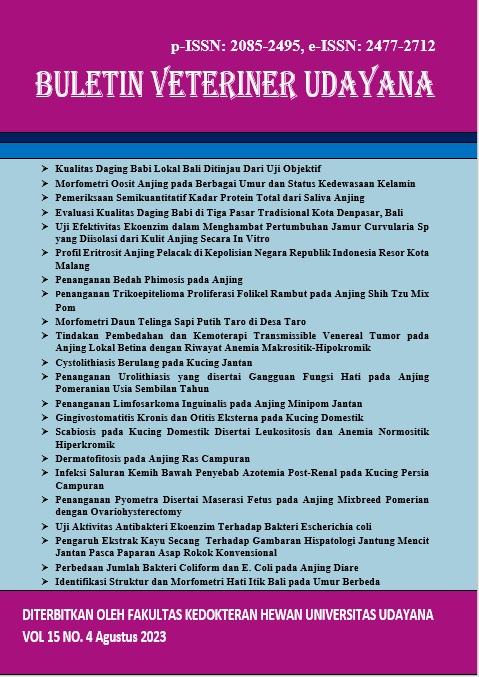TREATMENT OF UROLITHIASIS WITH LIVER FUNCTION DISORDERS IN A NINE YEARS OLD POMERANIAN DOG
Abstract
The purpose of writing this report is to discuss the incidence of urolithiasis accompanied by impaired liver function in male Pomeranian dogs in carrying out diagnostic and appropriate handling and therapy of case dogs. A nine years old male Pomeranian dog weighing 2.8 kg was brought to Estimo Petshop & Clinic with complaints of hematuria, stranguria accompanied by decreased appetite and drinking for the last five days and anuria for the last two days. On physical examination, the dog was dehydrated accompanied by pale eye and mouth mucosa, bladder distension and liver can be palpated. On radiographic examination found the presence of uroliths in the bladder and urethra accompanied by an enlarged liver size. The results of the hematological examination showed that the dog had decreased hematocrit and MCV values, increased MCHC, RDW and white blood cells. The results of blood biochemical examination showed increased levels of BUN, globulins, ALT and ALKP. Urine chemistry examination showed a pH of 6.0 and abnormal in bilirubin and erythrocytes. Microscopic examination of the urine revealed the presence of calcium oxalate crystals. Based on the anamnesis, physical examination and supporting examination, the case dog was diagnosed with urolithiasis accompanied by impaired liver function. The treatment carried out was the installation of a catheter and the administration of herbal medicines containing Kejibeling and the antibiotic Ciprofloxacin HCl. However, after five days, the case dogs were brought back with a deteriorating condition. The next treatment given is cystotomy and drugs in the form of; betaine hepatoprotector injection, Ciprofloxacin HCl, cystaid dog, liver health and special diet for urinary tract disease in dogs. One week postoperatively, the case dog was able to urinate well without finding any blood. Based on the anamnesis, physical examination and supporting examinations in the form of hematological examination, blood biochemistry, radiography and urine, the case dog was diagnosed with urolithiasis accompanied by impaired liver function, where the treatment in the form of inserting a catheter and administering kejibeling extract had not been able to have a significant impact on the case dog. then an operation was performed. Therefore, to avoid urolithiasis recurrence in case dogs, it is necessary to educate the owner regarding dietary management in the form of avoiding feeds that are high in protein and calcium and further handling of impaired liver function.
Downloads
References
Apriatya D, Yunani R, Widyawati R. 2017. Analisis urin kasus urolithiasis pada kucing tahun 2017 di Surabaya. Agrovet. 6(1): 82-84.
Bartges JW. 2016. Feline calcium oxalate urolithiasis. J. Feline Med. Surg. 18(9): 1532-2750.
Erwin, Asmilia N, Zuraida, Hadi ES. 2013. Kadar hemoglobin selama induksi anestesi per inhalasi dan anestesi per injeksi pada anjing lokal. Med. Vet. 7(2): 98-100.
Fossum TW, Dewey CW, Horn CV, Johnson AL, MacPhail CM, Radlinsky MG, Schulz KS, Willard MD. 2013. Small animal surgery. 4th Ed. Missouri: Elsevier.
Fossum TW. 2018. Small animal surgery e-book. Elsevier Health Sciences.
Fromsa A, Saini NS. 2019. Canine urolithiasis and concurrrent urinary bladder abnormalities: symptoms, haematology, urinalysis and comparative radiographic and ultrasonographic diagnosis. Vet. Med. Open. J. 4(1): 18-26.
Houston DM, Weese HE, Vanstone NP, Moore AE, Weese JS. 2017. Analysis of canine urolith submissions to the canadian veterinary urolith centre, 2014. Can. Vet. J. 58:45-50.
Humaira S, Widyastuti SK, Batan IW. 2021. Keberhasilan penanganan hematuria karena urolithiasis dengan manajemen diet dan suplemen glukosamin. Indon. Med. Vet. 10(6): 926-935.
Hurst RE. 1994. Structure, function, and pathology of proteoglycans and glycosaminoglycans in the urinary tract. World J. Urol. (12): 3-10.
Jaya IMAM, Putriningsih PAS, Soma IG. 2022. Infeksi canine parvovirus pada anjing lokal. Bul. Vet.Udayana. 14(1): 43-49.
Jordan R, Febrianix A, Yullius V, Hermawan IP. 2022. Feline lower urinary tract disease (flutd) pada kucing nobu di K and P Clinic. J. Vitek Bidang Ked. Hewan. 12(1): 46-49.
Kartika Y, Erina E, Asmilia N. 2020. Profil darah kucing domestik (Felis domesticus) yang menderita ear mites. J. Ilmiah Mahasiswa Vet. 5(1):1-9.
Kozat, Sepehrizade. 2017. Methods of diagnosis in liver disease for dog and cats. Turkish J. Sci. 10(2): 36-46.
Lehman H, Segal BH. 2020. The role of neutrophils in host defense and disease. J. Allergy Clin. Immunol. 145(6): 1535-1544.
Li X, Xu H, Gao P. 2021. Increased red cell distribution width predicts severity of drug-induced liver injury: a retrospective study. Sci. Rep. 11(773): 1-8.
Loesnihari R. 2012. Peran analisa urin pada penanganan penyakit ginjal dan traktus urinarius. Maj. Ked. Nusantara. 45(3): 167-176.
Mahindra AT, Batan IW, Nindhia TS. 2020. Gambaran hematologi anjing peliharaan di Kota Denpasar. Indon. Med. Vet. 9(3): 314-324.
Martinez C, Mooney CT, Shiel RE, Tang PK, Mooney L, O’Neill EJ. 2019. Evaluation of red blood cell distribution width in dogs with various illnesses. Can. Vet. J. 60(9): 964–971.
Men YV, Arjentina IPGY. 2018. Laporan kasus: urolithiasis pada anjing mix rottweiller. Indon. Med. Vet. 7(3): 211-218.
Mirahsanti NPN, Soma IG, Batan IW. 2022. Laporan kasus: radang peritonium menular pada kucing kampung yang diteguhkan dengan uji rivalta. Indon. Med. Vet. 11(3): 412-423.
Negasee KA. 2021. Hepatic diseases in canine and feline: a review. Vet. Med. 6(1): 22-31.
Nelson RW, Couto CG. 2014. Small animal internal medicine 5th edition, ed elsevier/mosby, st. Louis, MO, SUA.
Oh WS, Oh TH. 2010. A case of struvite urolithiasis in a one-month-old Korean sapsal dog. J. Vet. Clin. 27(4): 453-456.
Pallo-Zimmerman LM, Byron JK, Graves T. 2010. Fluoroquinolones: then and now. Compendium. 32(7): 1-9.
Sterczer A, Gaal T, Perge E, Rothuizen J. 2001. Chronic hepatitis in the dog - a review. Vet. Quart. 23: 148-152.
Suryandari P, Santi P, Fajar P. 2012. Kasus urolithiasis pada kucing. Malang: Universitas Brawijaya.
Tinureh D, Abdisa T. 2017. Review on canine urolithiasis. Am. Res. J. Vet. Med. 1(1): 1-7.
Tiselius HG. 1984. Urinary ph and calcium oxalate crystallization. Pathogenese und Klinik der Harnsteine X. 1(3): 184-185.
Yadav SN, Ahmed N, Nath AJ, Mahanta D, Kalita MK. 2020. Urinalysis in dog and cat: a review. Vet. World. 13(10): 2133-2141.





